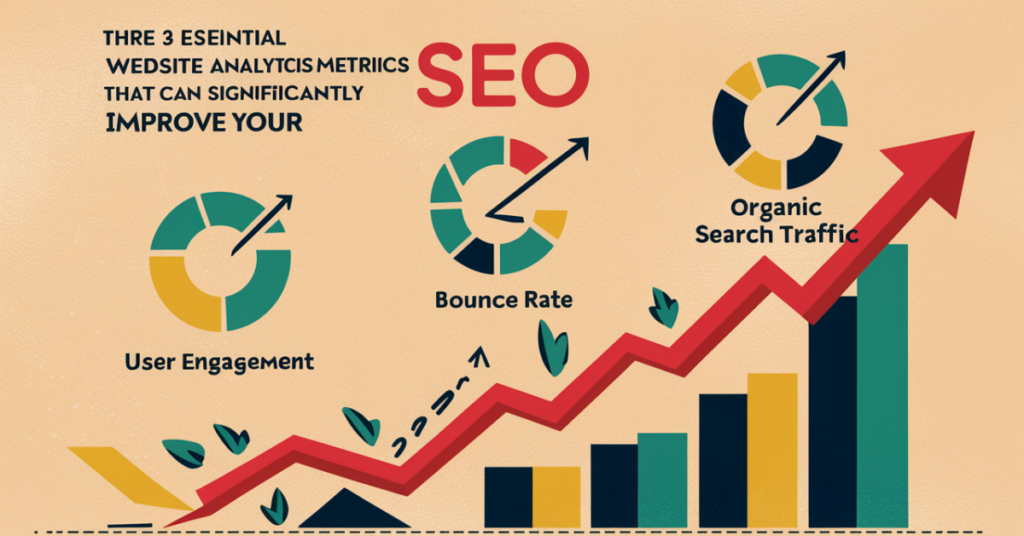Last Updated on June 11, 2024 by janetjacksondigital

SUMMARY
You may enhance your website’s performance as well as its search engine rankings and generate more lucrative organic traffic by maximizing these three website analytics metrics: organic visibility, organic traffic, and organic sessions.
3 WEBSITE ANALYTICS METRICS
Five business-oriented KPIs were discussed in a previous article to help you gauge the effectiveness of your SEO efforts. This week, I wanted to provide three website performance metrics that will also help you get better SEO. The term “organic” in this context refers to the popularity, relevancy, and intrinsic quality of your website’s content rather than paid advertising or sponsored promotions.
1. VISIBILITY TOGETHER
WHAT IS VISIBILITY THAT IS ORGANIC?
Online material that shows on search engine results pages (SERPs) without the use of paid advertising or promotions is referred to as “organic visibility,” sometimes known as “search visibility” or “SERP visibility.” The marketing KPI Share of Voice has an SEO variant. To be in the lead position on search engine results pages, you should ideally take up as much “digital real estate” as you can.
A Method for Assessing Organic Visibility
Keep tabs on SERP characteristics and keyword ranks with (incomplete list):
METHODS FOR ENHANCING ORGANIC VISIBILITY
Focus on the following to increase organic visibility:
1. Conduct keyword research to find high-traffic terms that are pertinent to your article.
2. material Optimization: Produce valuable, keyword-rich, high-quality material that meets user intent.
3. On-page search engine optimization: Make use of certain keywords to enhance title tags, meta descriptions, and header tags.
4. Backlink Building: Establish high-quality backlinks from reliable websites to raise your website’s organic visibility.
2. GOOGLE TRAFFIC
WHAT IS ORGANIC TRAFFIC?
The quantity of visitors that arrive from organic search engine results as opposed to sponsored adverts is known as organic traffic. In order to maximize your impressions, you must first build your organic visibility and establish a strong online presence by raising your keyword ranks. Next, in order to increase your click-through-rate—the percentage of visitors that click on your website title in SERPs and visit your website—you will need to optimize your visibility on SERPs.
Important Google Analytics Metrics Every Digital Marketer Should Watch
ANALYZING ORGANIC TRAFFIC
Use to monitor organic traffic
- The Position Tracking of Semrush
- Google Analytics > “All Traffic” > “Channels” > “Organic Search” > “Acquisition”
- Google Catalog
- Google Analytics linked with your content management system (CMS).
METHODS FOR ENHANCING ORGANIC TRAFFIC
Take into consideration the following tactics to boost organic traffic:
- Optimize your content for search intent by focusing on long-tail keywords.
- Mobile-Friendly Website: Make sure your website is designed for mobile devices to meet the growing demand from consumers who access it on the go.
- Improve site speed: By making pages load faster, you can improve both user experience and search engine rankings.
- Content marketing: To increase organic traffic and backlinks, provide informative, shareable content.
3. NATURAL CONFERENCIALS
HOW DO ORGANIC SESSIONS WORK?
The quantity of visits to a website that come from people clicking on its links in organic search engine results, free of any paid advertising directly on the page, is known as “organic sessions. Stated differently, ensure that your visitors come back as frequently as possible when they do.
MEASUREMENT GUIDE FOR ORGANIC SESSIONS
Utilize to keep tabs on organic sessions:
- The Position Tracking of Semrush
- Google Analytics > “All Traffic” > “Channels” > “Organic Search” > “Acquisition”
- Google Catalog
WAYS TO MAINTENANCE ORGANIC SESSIONS
To optimize organic sessions, take into account these strategies:
- User Experience (UX): Make sure your website provides a seamless, visually appealing, and easy-to-navigate experience for users.
- Site information Structure: Use headers and subheadings to logically arrange your information.
- Use internal linking to direct users to pertinent pages and maintain user engagement.
- Social Media Promotion: To improve visibility and generate organic traffic, share your insightful material on social media sites.
CONCLUSION
Use website analytics to improve your SEO. You may enhance search engine results, increase website performance, and draw in more lucrative organic visitors by concentrating on organic visibility, organic traffic, and organic sessions. The path to long-term SEO success will be paved with constant observation and modification depending on insights from website analytics, which will eventually result in expanded online presence and business expansion.

My name is Janet Jackson Seo and I work as a SEO Expert. I appreciate the process of developing an innovative approach and employing logic, particularly when it concerns future studies and SEO optimization. As an SEO expert I have known how to set up SEO campaigns fully and how to monitor their achievements.





